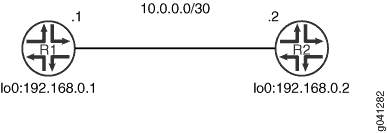ON THIS PAGE
Example: Enabling Packet Checksums on IS-IS Interfaces for Error Checking
This example shows how to enable packet checksums for IS-IS interfaces.
Requirements
Before you begin, configure IS-IS on both routers. See Example: Configuring IS-IS for information about the sample IS-IS configuration.
Overview
Junos OS supports IS-IS checksums as documented in RFC 3358, Optional Checksums in Intermediate System to Intermediate System (ISIS).
IS-IS protocol data units (PDUs) include link-state PDUs, complete sequence number PDUs (CSNPs), partial sequence number PDUs (PSNPs), and IS-IS hello (IIH) packets. These PDUs can be corrupt due to faulty implementations of Layer 2 hardware or lack of checksums on a specific network technology. Corruption of length or type, length, and value (TLV) fields can lead to the generation of extensive numbers of empty link-state PDUs in the receiving node. Because authentication is not a replacement for a checksum mechanism, you might want to enable the optional checksum TLV on your IS-IS interfaces.
The checksum cannot be enabled with MD5 hello authentication on the same interface.
Figure 1 shows the topology used in this example.

This example describes the steps on Device R1.
Configuration
Procedure
CLI Quick Configuration
To quickly configure
this example, copy the following commands, paste them into a text
file, remove any line breaks, change any details necessary to match
your network configuration, and then copy and paste the commands into
the CLI at the [edit] hierarchy level.
Device R1
set protocols isis traceoptions file isis set protocols isis traceoptions flag all set protocols isis interface fe-1/2/0.1 checksum
Step-by-Step Procedure
The following example requires you to navigate various levels in the configuration hierarchy. For information about navigating the CLI, see Using the CLI Editor in Configuration Mode in the CLI User Guide.
To configure IS-IS checksums:
Enable checksums.
[edit protocols isis interface fe-1/2/0.1] user@R1# set checksum
(Optional) Enable tracing for tracking checksum operations.
[edit protocols isis traceoptions] user@R1# set file isis user@R1# set flag all
Results
From configuration mode, confirm your configuration
by entering the show protocols commands. If the output
does not display the intended configuration, repeat the instructions
in this example to correct the configuration.
user@R1# show protocols
isis {
traceoptions {
file isis;
flag all;
}
interface fe-1/2/0.1 {
checksum;
}
}
If you are done configuring the device, enter commit from configuration mode.
Verification
Confirm that the configuration is working properly.
Verifying Checksums
Purpose
Verify that checksums are performed.
Action
From operational mode, enter the show log isis
| match checksum command.
user@R1> show log isis | match checksum May 31 16:47:39.513267 sequence 0x49 checksum 0x8e64 May 31 16:47:39.513394 sequence 0x4e checksum 0x34b3 May 31 16:47:39.513517 sequence 0x50 checksum 0x9dcb May 31 16:47:46.563781 sequence 0x45 checksum 0x7e1a May 31 16:47:46.563970 sequence 0x46 checksum 0x226d May 31 16:47:46.564104 sequence 0x52 checksum 0x99cd May 31 16:47:46.581087 sequence 0x49 checksum 0x8e64 May 31 16:47:46.581222 sequence 0x4e checksum 0x34b3 May 31 16:47:46.581353 sequence 0x50 checksum 0x9dcb May 31 16:47:55.799090 sequence 0x45 checksum 0x7e1a May 31 16:47:55.799223 sequence 0x46 checksum 0x226d May 31 16:47:55.799347 sequence 0x52 checksum 0x99cd May 31 16:47:55.818255 sequence 0x49 checksum 0x8e64 May 31 16:47:55.818473 sequence 0x4e checksum 0x34b3 May 31 16:47:55.818606 sequence 0x50 checksum 0x9dcb May 31 16:48:03.455816 sequence 0x49 checksum 0x8e64 May 31 16:48:03.455973 sequence 0x4e checksum 0x34b3
Meaning
The output shows that checksum information is captured in the IS-IS trace log file.
